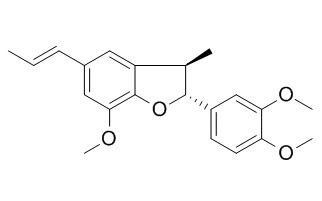Acuminatin
(-)-Acuminatin exerts hepatoprotective activities, perhaps by serving as a potent antioxidant. (+)-trans-Acuminatin, and (+)-cis-acuminatin show weak activity against platelet aggregation with IC50 values of 108.5 and 90.02 uM, respectively.(-)-Acuminatin, and machilin G show dose-dependent potent inhibitory activities against PLCgamma1 in vitro with IC50 values ranging from 8.8 to 26.0 microM, the inhibition of PLCgamma1 may be an important mechanism for an antiproliferative effect on the human cancer cells, therefore, these inhibitors may be utilized as cancer chemotherapeutic and chemopreventive agents.
Inquire / Order:
manager@chemfaces.com
Technical Inquiries:
service@chemfaces.com
Tel:
+86-27-84237783
Fax:
+86-27-84254680
Address:
1 Building, No. 83, CheCheng Rd., Wuhan Economic and Technological Development Zone, Wuhan, Hubei 430056, PRC
Providing storage is as stated on the product vial and the vial is kept tightly sealed, the product can be stored for up to
24 months(2-8C).
Wherever possible, you should prepare and use solutions on the same day. However, if you need to make up stock solutions in advance, we recommend that you store the solution as aliquots in tightly sealed vials at -20C. Generally, these will be useable for up to two weeks. Before use, and prior to opening the vial we recommend that you allow your product to equilibrate to room temperature for at least 1 hour.
Need more advice on solubility, usage and handling? Please email to: service@chemfaces.com
The packaging of the product may have turned upside down during transportation, resulting in the natural compounds adhering to the neck or cap of the vial. take the vial out of its packaging and gently shake to let the compounds fall to the bottom of the vial. for liquid products, centrifuge at 200-500 RPM to gather the liquid at the bottom of the vial. try to avoid loss or contamination during handling.
Agriculture.2022, 12(3), 342.
Phytother Res.2019, 33(7):1784-1793
Ann Transl Med.2019, 7(23):731
Adaptive Medicine 2020, 12(1): 4-10
In Vivo.2022, 36(3):1136-1143.
J Tradit Chin Med.2023, 43(6):1081-1091.
Int. J. Mol. Sci.2022, 23(19), 11900.
Front Pharmacol.2023, 14:1095083.
ScienceAsia2024, 50,2024073:1-9
J Pharmaceutical and Biomedical Analysis2022, 114631.
Related and Featured Products
J Pharm Pharmacol. 2000 Sep;52(9):1163-9.
Antioxidant lignans from Machilus thunbergii protect CCl4-injured primary cultures of rat hepatocytes.[Pubmed:
11045899]
METHODS AND RESULTS:
Eleven lignans (1-11) were isolated from the CH2Cl2 fraction of the bark of Machilus thunbergii Sieb. et Zucc. (Lauraceae). These were identified as (-)-Acuminatin (1), (-)-isoguaiacin (2), meso-dihydroguaiaretic acid (3), (+)-galbacin (4), (-)-sesamin (5), (+)-galbelgin (6), machilin A (7), machilin G (8), licarin A (9), and nectandrin A (10) and B (11). Primary cultures of rat hepatocytes were co-incubated for 90 min with the hepatotoxin CCl4 and each of the 11 lignans (50 microM). Hepatoprotective activity was determined by measuring the level of glutamic pyruvic transaminase released into the medium from the primary cultures of rat hepatocytes. (-)-Acuminatin, (-)-isoguaiacin and meso-dihydroguaiaretic acid all significantly reduced the level of glutamic pyruvic transaminase released. Further investigation revealed that these three compounds significantly preserved the levels and the activities of glutathione, superoxide dismutase, glutathione peroxidase and catalase. (-)-Acuminatin, (-)-isoguaiacin and meso-dihydroguaiaretic acid also ameliorated lipid peroxidation as demonstrated by a reduction of malondialdehyde production.
CONCLUSIONS:
These results suggest that (-)-Acuminatin, (-)-isoguaiacin and meso-dihydroguaiaretic acid exert diverse hepatoprotective activities, perhaps by serving as potent antioxidants.
Phytochemistry. 2016 Sep;129:36-44.
Amides and neolignans from the aerial parts of Piper bonii[Pubmed:
27452451 ]
METHODS AND RESULTS:
Six amides, piperbonamides A-F, three neolignans piperbonins A-C, and 11 known compounds were isolated from the aerial parts of Piper bonii (Piperaceae). The structures of piperbonamides A-F and piperbonins A-C were elucidated based on the analysis of 1D and 2D NMR and MS data.
CONCLUSIONS:
Piperbonin A, (+)-trans-Acuminatin, (+)-cis-Acuminatin, (+)-kadsurenone, and pipernonaline showed weak activity against platelet aggregation with IC50 values of 118.2, 108.5, 90.02, 107.3, and 116.3 μM, respectively, as compared with the positive control, tirofiban, with an IC50 value of 5.24 μM. Piperbonamides A-F were inactive against five tumor cell lines at concentrations up to 40 μM.
Arch Pharm Res. 2004 Oct;27(10):1043-7.
Inhibition of phospholipase Cγ1 and cancer cell proliferation by lignans and flavans from Machilus thunbergii[Pubmed:
15554262]
Thirteen compounds were isolated from the CH2Cl2 fraction of Machilus thunbergii as phospholipase Cgamma1 (PLCgamma1) inhibitors.
METHODS AND RESULTS:
These compounds were identified as nine lignans, two neolignans, and two flavans by spectroscopic analysis. Of these, 5,7-di-O-methyl-3',4'-methylenated (-)-epicatechin (12) and 5,7,3'-tri-O-methyl (-)-epicatechin (13) have not been reported previously in this plant. In addition, seven compounds, machilin A (1), (-)-sesamin (3), machilin G (5), (+)-galbacin (9), licarin A (10), (-)-Acuminatin (11) and compound 12 showed dose-dependent potent inhibitory activities against PLCgamma1 in vitro with IC50 values ranging from 8.8 to 26.0 microM. These lignans, neolignans, and flavans are presented as a new class of PLCgamma1 inhibitors.
CONCLUSIONS:
The brief study of the structure activity relationship of these compounds suggested that the benzene ring with the methylene dioxy group is responsible for the expression of inhibitory activities against PLCgamma1. Moreover, it is suggested that inhibition of PLCgamma1 may be an important mechanism for an antiproliferative effect on the human cancer cells. Therefore, these inhibitors may be utilized as cancer chemotherapeutic and chemopreventive agents.



